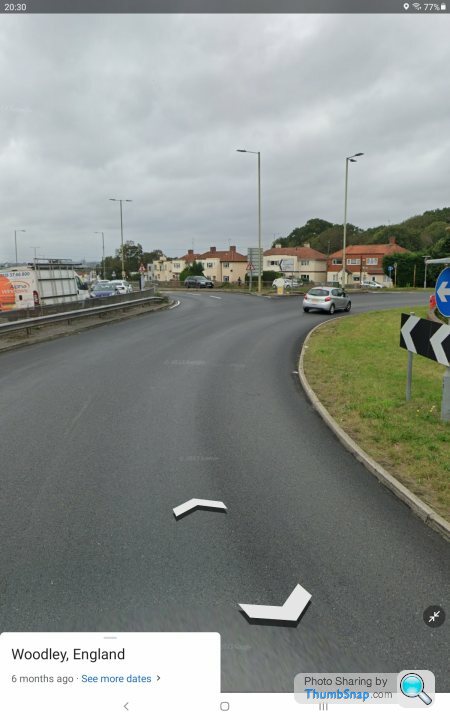Mrs got into a fender bender
Discussion
A better look at the layout. BMW has been more than a little unobservant if the OP's wife was still indicating right.
In the unlikely event of being in the OP's wife position I'd have been very wary of a vehicle to my right. Vice versa for the BMW. Like most on here, in both cases, I'd avoid being alongside if possible, even if it meant braking.
Woodley, England
https://maps.app.goo.gl/VRsnV4JviFrfp49L7

In the unlikely event of being in the OP's wife position I'd have been very wary of a vehicle to my right. Vice versa for the BMW. Like most on here, in both cases, I'd avoid being alongside if possible, even if it meant braking.
Woodley, England
https://maps.app.goo.gl/VRsnV4JviFrfp49L7

MightyBadger said:
If you look at the ops picture you will see two massive arrows pointing straight on, that means you can be in either lane to continue straight on to the A road, which means he didn't leave his lane or change his course or was in the wrong place.
Ops mrs made the fundamental mistake when she turned the wheel.
Have a nice evening, stay safe on the road.
According to the Highway Code, the arrows are indications of lanes. They're not giving any instruction. Obviously, the indication they give is the same for both lanes.Ops mrs made the fundamental mistake when she turned the wheel.
Have a nice evening, stay safe on the road.
Re opinions that the junction is not a roundabout, I haven't seen anything that confirms that, ie looking on Google street view I haven't seen a rectangular one way sign, only the circular signs indicating direction. Tbf I haven't looked on approaching roads for any roundabout signs.
Either way, roundabout or gyratory, I don't consider the junction as a straightonabout, so I'm not agreeing that any road signs or markings are instructing or directing traffic to proceed onto the A4 south-west; there is at the north-east end of it though.
I still say, were a car to exit M&S or possibly also Reading Road onto lane 1 of that junction, with the intention of heading north, they would be okay proceeding around while staying in lane 1, which means anyone in lane 2 intending to exit on A4 south west would need to take care.
Pica-Pica said:
It is most certainly not a roundabout. How many more times, it is a gyratory system, one-way street and general motoring ‘rules’ apply. There is absolutely no point quoting roundabout rules.
Yet, (some) people keep going on about how one vehicle crossed paths with another when leaving said fictional roundabout.Pica-Pica said:
It is most certainly not a roundabout. How many more times, it is a gyratory system, one-way street and general motoring ‘rules’ apply. There is absolutely no point quoting roundabout rules.
Road design in the UK is governed by the DMRB - Design Manual for Roads and Bridges. The DMRB does briefly mention gyratories in one section. That section is titled "Geometric Design of Roundabouts". Gyratory does not appear in any of the other sections of the DMRB that cover other junction types.The Highway Code does not mention gyratories.
I'm stating no opinion here, I'm just asking if you could confirm you believe a gyratory is a junction type not covered by the Highway Code that is only covered by the document on UK road designs in the section on roundabouts but that isn't a roundabout?
Gyratory has a number of definitions from different sources and seem to be a point of contention. Google's definition states "a road junction or traffic system requiring the circular movement of traffic, larger or more complex than an ordinary roundabout." Whilst this definition isn't great, I would suggest that the presence of "larger or more complex than an ordinary roundabout" does not mean that one is not a roundabout, merely that it is "larger or more complex than an ordinary roundabout".
The mention of gyratory on Wikipedia (for what that's worth) is under "Roundabout" and the citation for it is a book on roundabouts.
Please can you confirm where we find the correct rules for a gyratory?
Gassing Station | Speed, Plod & the Law | Top of Page | What's New | My Stuff




